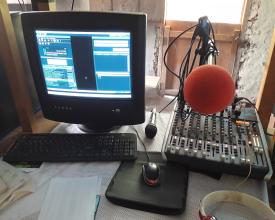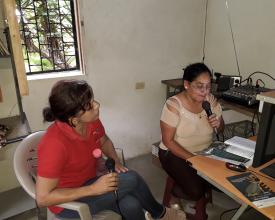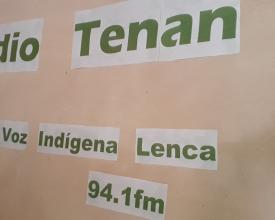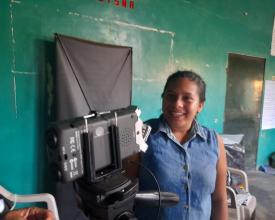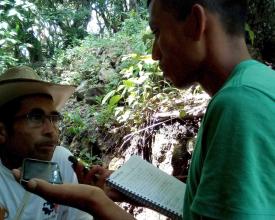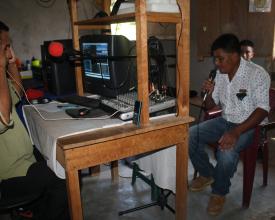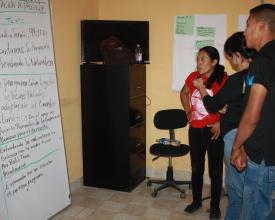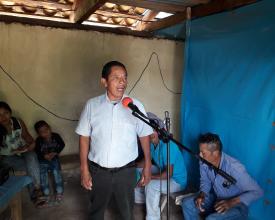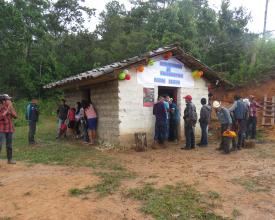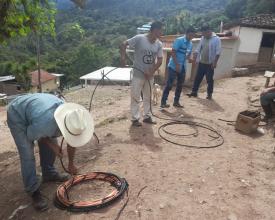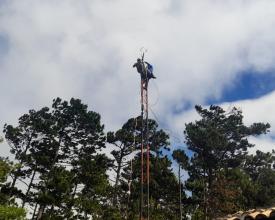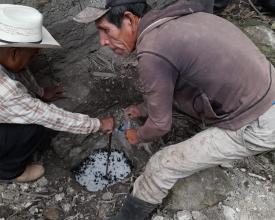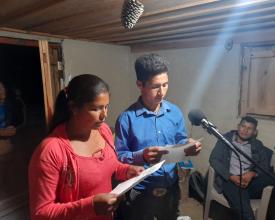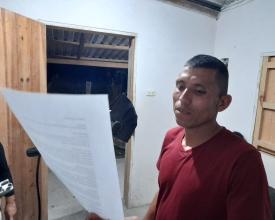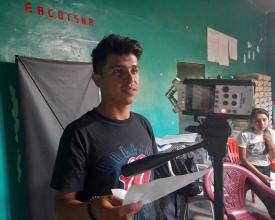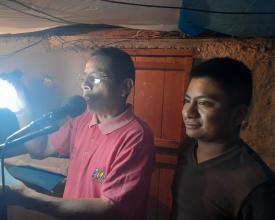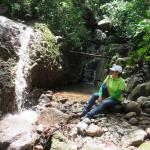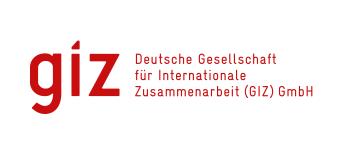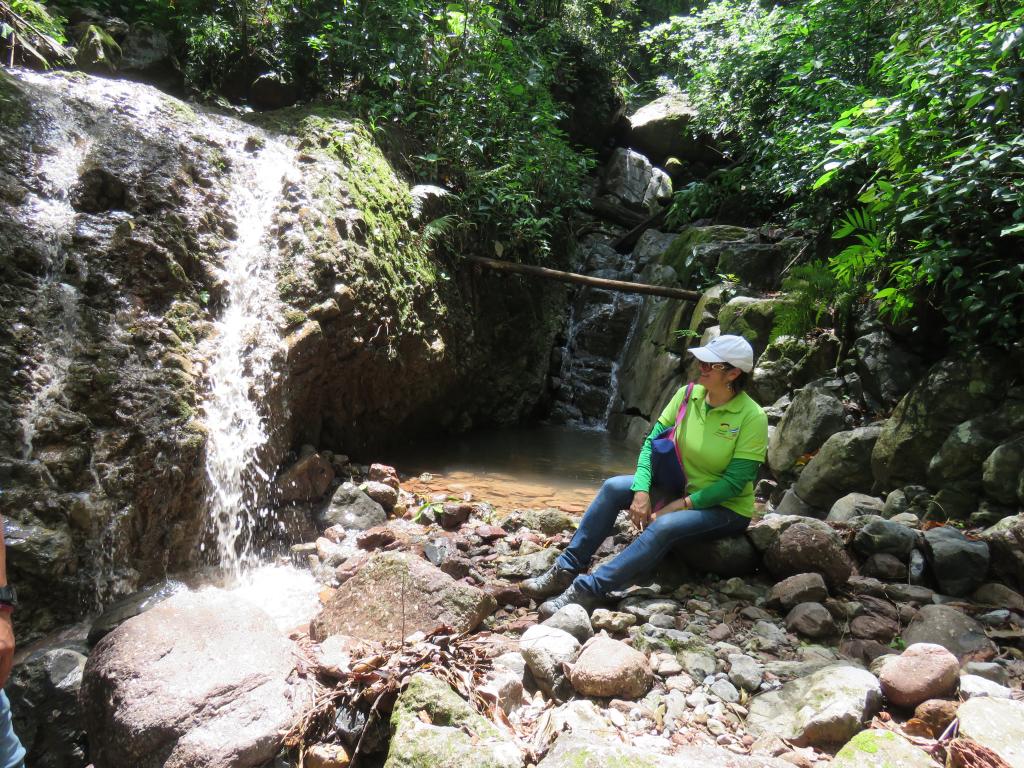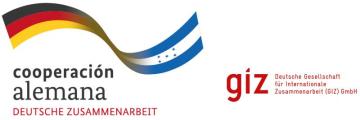
Community radio: strategic allies for raising awareness and promoting biosphere reserve sustainability
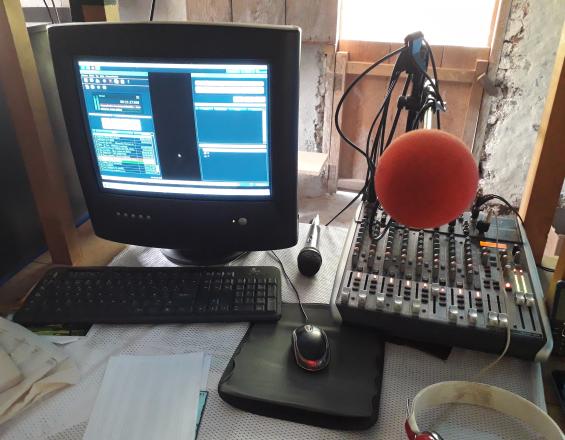
The scope of community radios for the protection of natural resources should be part of the actions implemented by development projects in the communities surrounding protected areas, biological corridors and biosphere reserves.
Since the beginning of the PROCAMBIO project in the Cacique Lempira Señor de las Montañas Biosphere Reserve (RBCLSM), the three community radio stations have become a strategic ally for the dissemination of content aimed at raising awareness among the population on climate change, adaptation measures, agroforestry systems, ecosystem services and sustainability, among others.
The participating community stations are Radio Tenán, Radio Taragual and Radio La Voz de Puca, the first is located in the Montaña de Celaque National Park (PNMC) and the other two in the Montaña de Puca Wildlife Refuge (RVSMO), both protected areas are part of the biosphere reserve.
Context
Challenges addressed
- The team of communicators was unaware that UNESCO declared the territory a biosphere reserve in 2015, so an environmental education process was initiated to train them on the subject.
- The nature of community radio is to promote collective participation and popular education through informative and entertaining content spaces with their own identity.
- A participatory diagnosis was carried out to identify the needs of the technical team of each radio station, as well as training needs, in order to expand content production and improve the quality of the signal during transmissions.
- Although these radio stations do not know their rating, their coverage reaches the municipalities of San Marcos de Caiquín, San Sebastián, San Manuel de Colohete, La Campa, Belén Gualcho, Gracias, Las Flores, all within the biosphere reserve territory, as well as La Iguala, Lepaera, San Juan de Opoa, La Unión, Santa Cruz and Erandique.
Location
Process
Summary of the process
- Environmental education should be present throughout people's lives as they acquire greater environmental awareness at each stage.
- Community radio stations are strategic allies for development projects aimed at environmental protection because their programming contributes to community awareness and reflection.
- They have coordinated with other local biosphere reserve stakeholders to participate in different spaces to disseminate content that educates about the importance of biosphere reserves, the impacts of climate change, and the importance of human life and ecosystems.
- The team of communicators should be in constant training, updating their knowledge on different topics and strengthening their capacities in the production of radio programs.
- Development projects should generate alliances to strengthen community radio stations, since they are perhaps the main channel to reach communities directly.
- Community radio stations have an impact, involve the population and promote local policies that favor the sustainable development of the communities in the reserve's territory.
Building Blocks
Environmental education and awareness
Once the results of the participatory diagnosis were identified, a capacity building plan was developed for the creation of productions with environmental content. This process included the issue of community radio in the development of indigenous communities, since the three radio stations are located in indigenous municipalities and belong to the Lenca ethnic group. During this stage, the communicators reflected on the role of radio in community development and its role as an agent of social change in the protection of natural resources and the sustainability of the reserve.
Enabling factors
- Concepts of biosphere reserves, climate change, adaptation and sustainability were reinforced.
- Reflections were generated about the role of community radio in the protection of natural resources and how the different radio broadcasts should raise awareness among the population about the effects of climate change on the biosphere reserve.
- The communicators created their own scripts for the production of environmental programs.
Lesson learned
- Generating alliances with the community media is an excellent tool for raising awareness among the different target audiences about the scope of the projects.
- As the voice of the communities, they influence public opinion and address issues that the communities face, that is, they manage their own media agenda.
- They promote the participation of the population, educate and revalue ancestral traditions and knowledge on indigenous law, defend natural resources and contribute to the construction of democracy.
Strengthening capabilities
Since the three community radio stations, Tenán, Taragual and La Voz de Puca were founded in 2014, the technical equipment with which they started was damaged over time and because the radios are located in areas far away from urban centers, access to qualified personnel for repairs has been very complicated. As a result, the electronic equipment became obsolete and in poor condition. In addition to the above, none of the three community radio stations had lightning antennas and when there were electrical discharges during the rainy season, the transmitter was burned, causing the stations to remain out of the radio spectrum.
Therefore, the strengthening of community radio stations included the provision of radio broadcasting equipment to improve the signal and coverage.
Enabling factors
- Theoretical and practical workshops were held for the installation of lightning antennas. Each station now has its own antenna and this has helped prevent lightning strikes from affecting the equipment during the winter.
- The equipment that was obsolete and damaged was replaced with more modern radio broadcasting equipment in good condition, which has allowed each station to improve the transmission signal.
Lesson learned
- Facilitating theoretical and practical workshops on equipment repair and installation allows radio stations to keep the signal on the dial and, therefore, the message they want to transmit is available to the audience.
- The team of communicators of each radio station is able to identify when equipment has been damaged and knows what to do to repair it.
- Strengthening knowledge in the repair of electronic equipment, installation of cables, replacement of parts, electrical conduction, among others, means that radios do not have to depend on a third party to correct defects or have to go off the dial for an indefinite period of time until an expert arrives to fix the problem.
Creating environmental awareness
Workshops were held to reinforce knowledge of the Sustainable Development Goals (SDGs), biosphere reserve management, climate change, sustainability, watershed management and agroecology, among others.
Capacities were developed for the creation of programs that contribute to the biosphere reserve management processes through the transmission of environmental programs.
Among the communication pieces, scripts were created for podcasts, which addressed the topic of biosphere reserves and their relationship with the SDGs and climate change.
An example of this is the podcast by La Voz de Puca, entitled "Área protegida Refugio de vida silvestre Montaña de Puca", which mentions SDG6 and how the mountain is a producer of water.
Radio Taragual created the slogan "Let's return to our roots so as not to destroy our common home", which was created after reflecting on the impacts of climate change and deforestation.
Radio Tenán produced informative capsules on UNESCO's MaB Program for the declaration of biosphere reserve territories, highlighting the four reserves in Honduras.
Enabling factors
In order to sensitize the audience of each community radio station, it was first necessary to organize environmental education workshops with the teams of communicators from the three stations.
They were trained in the SDGs, with emphasis on those linked to the reserve, such as SDG6, SDG12, SDG13 and SDG15.
Radio productions included informative capsules, radio spots and podcasts. They also produced curtains and stamps for each radio station, all with an environmental focus and highlighting the fact that they live in a biosphere reserve.
Lesson learned
- Community radio is a strategic ally for addressing issues that generate behavioral changes in communities.
- The production of environmental programs within the programming encourages creativity, curiosity about environmental issues and at the same time, promotes reflection on the impacts of climate change and damage to ecosystems.
- Development projects, especially those aimed at environmental conservation and protection, should seek alliances with community radio stations in the areas of intervention.
- Each community radio station has its own identity and editorial line, maintains and addresses the problems faced by the communities with a proactive approach, generating participation and influencing, through the content of each program, to generate opinion and behavioral changes among the audience.
Impacts
- The radio stations have expanded their programming by producing programs oriented towards the sustainability of the reserve's natural resources.
- The team of communicators knows and understands the concept of living in a biosphere reserve and transmits this to their listeners through the different programs.
- Climate change and its impact on the livelihoods of families have been addressed, as well as programs on risk management, in order to raise awareness and achieve behavioral changes among the population.
- Campaigns have been created against forest fires, where it is recommended to leave behind the old practices of burning the plot as a way to prepare the soil for the new planting season.
- Programs aimed at organic and agroecological agriculture have been created as measures for adapting to climate change.
- Alliances have been generated with local government institutions, commonwealths, central government and civil society organizations for the implementation of new programs.
- The signal and coverage of each radio station has been improved. In addition, the volunteer communicators have expanded their knowledge of radio broadcasting equipment.
- The radio booths have been equipped with office equipment, electronics and beam antennas to guarantee a better signal and greater efficiency to address the different programs.
Beneficiaries
The radios operate through the volunteer work of 31 people, being the direct beneficiaries, taking into consideration the total population, the reach of the radios can reach 121,434 people indirectly.
Sustainable Development Goals
Story
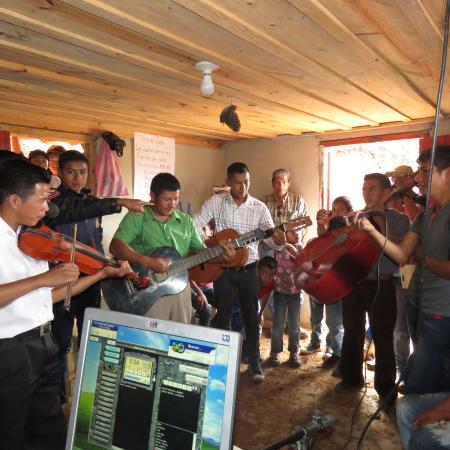
In the Cacique Lempira Señor de las Montañas Biosphere Reserve, located in western Honduras, there are three indigenous community radio stations: Tenán, Taragual and La Voz de Puca, located in the buffer zones of two protected areas, Montaña de Celaque National Park and Montaña de Puca Wildlife Refuge.
Each radio station has a team of volunteers to broadcast informative and entertaining programs, including programs on traditional medicine and indigenous law, among others. Like all community radio, its purpose is to provide a response to the audience on economic, social, political and environmental conflicts that the communities are going through.
Another characteristic is that they are not for profit, like commercial radio stations, so they do not have sufficient resources to improve or expand their electronic equipment, which has often prevented them from remaining outside the radio spectrum.
The generation of alliances is a fundamental tool for these community radio stations to remain on the dial. Therefore, for the PROCAMBIO project, the radio stations have been a strategic ally for the dissemination of information and content aimed at the sustainability of the biosphere reserve.
For Manuel Castañeda, coordinator of the community radio station La Voz de Puca, the strengthening processes have contributed to the training of communicators and have allowed them to participate in other media to talk about the impacts of climate change in the RBCLSM.
Castañeda recalled that the radio was off the radio spectrum for about 11 months due to a lightning strike, but now with the installation of the lightning antenna, having been "off the air" is a thing of the past.
For Lorenzo Cortés and Martina López, of Radio Tenán, the radio has also contributed to the revaluation of the ancestral traditions and culture of the Lenca people. For this team of communicators, the radio is the "voice of the Lenca people", as its slogan indicates, since it has contributed to the promotion and respect for indigenous rights.

